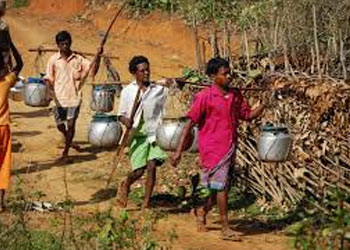BONDA/BONDO TRIBE OF ODISHAThe high hills lacated towards the remote South-Western tip of the Malkangiri uplands and North-West of the river Machkund in the District of Koraput are inhabited by sparsely populated primitive tribes. The Bondos / Bondas are on of them and the hills on which they live are called the Bondo/Bonda Hills. Once they were regarded as aggressive tribes of Odisha. Though little in number the tribe has successfully retained the distinctive features of its culture, chiefly on account of its geographical isolation and more perhaps due to its stubborn and independent spirit. Their language is called REMO, which comes under the Austro-Asiatic Language belonging to the Mundari Group. HOUSE PATTERN OF ODISHA BONDA TRIBE A Bondo hut/house consists of two rooms. The large room which is used for sleeping cum cooking. It is 8 feet wide and 6 feet long with some raised platforms at each corners to keep utensils and containers of water. The smaller room which is hardly about 5 feet in length and 4 feet in width is used for granary. There is a door between the two rooms used as interconnecting door. They have basically two doors in the entire house. One is entrance and the other is interconnecting. Apart from these two doors there is no other doors or windows. The walls of the rooms are made with straw mixed with mum or plastered bamboo.
THE TRIBE IS DIVIDED INTO THREE GROUPS. 1. The Upper Bondos or Bara-Jangar group, who live on the slpes at 3,000 feet above sea level. 2. The Lower Bondos live at the foot hills under symbiotic pressure of the surrounding peasantry. 3. The Gadaba-Bondos are being greatly influenced by the Gadabas, live at the same altitude as the Upper Bondos. Both Bara Jangar & Gadaba-Bondos are considered Hill Bondos. |
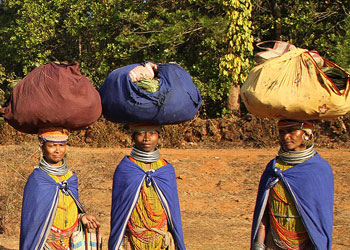
CLOTHINGS: WOMEN CLOTHINGS
MEN CLOTHINGS |
GADABA TRIBE ODISHAThe Gadaba are also one of the colourful tribes of Odisha out of 62 Tribes living in the state Odisha earlier Orissa. They are mostly found in the Southern part of the state in Koraput and Malkangiri Districts. The larger inhabitants are found in the Blocks of Lamtaput, Nandapur, Pottangi & Khairiput. HOUSE PATTERN of Gadaba tribes The Gadabas normally build their houses in two rows facing each other. There is a long gap between the two rows of the houses. The House of the village Headman is in the middle one of the row. His house is biggest among other villagers. In front of the Headman’s House or in the center of the village they plant a tree. They also build a platform with the help of rocks / stones. That place is meant for the leaders of the villagers where they can sit and give decisions to the dispute of the village. Also they use this place during the time of festival. They came to this place to dance and drink. The economic life of Gadaba mainly depend on agriculture. Apart from agriculture they also depend on forest produces, hunting and fishing. Formerly these tribes were doing shifting cultivation unlike Bondos. But now a days the practice has declined considerably. They mainly grow ragi, suan, millet etc.
|
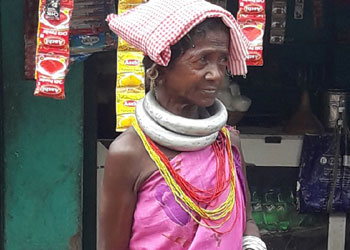
WOMEN CLOTHINGS Then ladies are very fond of ornaments to decorate their bodies. These ornaments are generally made of brass or aluminum. They comb their hairs very neatly and use hair pins. They also use ornaments in their noses and fingers. They use bangles sometimes. MEN CLOTHINGS Gadabas use very scanty clothes for their dress. The men use a piece of cloth called LENGUTHI with a flap which hangs down in front. But with modern style now a day they use DHOTI & SHIRT. The women wear a long strip of cloth known as KERANG tied around the waist and the second piece of cloth is worn across chest and fixed at the left or sometimes at right shoulder with a large knot. |
DIDAYI TRIBE OF ODISHAThe Didayi Tribes are a small group among the sixty two (62) type of tribes in Odisha earlier Orissa. They are normally found in the hill ranges of Eastern Ghats in Malkangiri District. In past the Didayi Tribes were in habit of shifting cultivation by clearing the forest land. But recently they are following modern technology and do settled cultivation in the plain and mountain regions. In Didayi villages, houses lie scattered. Sometimes two to three houses are built facing a common courtyard. The house with the kitchen garden close to it always protected with a fence.. HOUSE PATTERN OF DIDAYI TRIBE The Didayi Houses are building in a rectangular style. Each house consists of veranda with door. The houses have mud walls and two slope roofs covered with wild grass. The kitchen room is in the corner, in the middle is sleeping room and the other part is used for storage place to keep grains and other household things. |
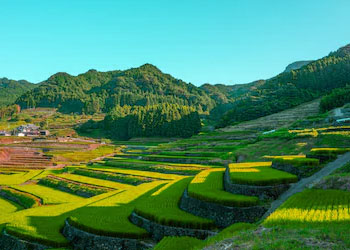 |
KANDHA TRIBE ODISHAKandha Tribe is the largest group among the 62 types of tribes of Orissa. They are mostly found in the districts of Rayagada & Kandhamal. This group of tribes are divided into three (3) parts, like Kutia Kandha (Tatoo Faced tribe), Dongariya Kandha & Desia Kandha. These tribes were famous for human sacrifice (in earlier times) for better crop. But that practise has been replaced with the sacrifice of buffalo / goat / chicken. The Desia Kandha tribes settles themselves in the plains and coastal areas. They are the modernised tribe among the other tribes. They represent the Hinduized section of the tribe. They are settled agriculturists. They mostly found in Rayagada Districts. The settlement pattern of the Kandha village is of linear type. Two rows of houses on either side of the village street. The thatched roofs are merged in such a way that it seems to be one long roof with different rooms. But now a days the tribes have build modern concrete houses with the help from Government. There is a place of Earth Goddess at the centre of the village street. HOUSE PATTERN of Kandha tribes The Kondh Tribe always take permission from the chief or headman of the village before constructing a new house. The house generally consisting of two verandahs both front and back with living room and a small room meant for kitchen. The olden houses are made of mud and thatched roof. The ceiling of the houses is low. Whereas the Kondh leaves in Kandhamal District leaves in wooden planks or bamboos plastered. |
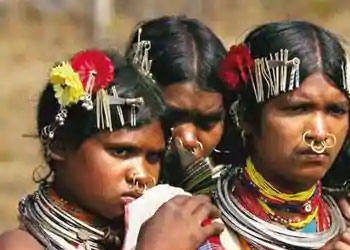
KANDHA ORNAMENTS Kandha tribes women are very fond of ornaments. Mostly Dongariya Kandha women makes them beautify with hair-pins, earrings, nose rings and necklaces. Wristlets and earrings are used by the men among the primitive sections. Dongariya Kandha men grow hairs long and tie it into a knot at the nape of the neck with comb and hair pins fixed to it. Whereas Desia Kandha follows the Hindus. The Kutia Kandha tattoo their faces and hands. |
PAROJA / PARAJA TRIBES OF ODISHAParoja / Paraja tribes are one of the major tribes in Odisha. They are mostly found in Koraput District of Odisha (earlier known as Orissa). This term Paroja is a local term which appears to be a Sanskrit word of Praja. Praja means the common people of the country who are ruled by Raja (King) or Jamindars (Landlords). The Paroja tribes normally leave with other communities like Rana, Paika, Mali, Domb, Gadaba & Kandha. This tribe is also divided into four parts. 1. Bada Paroja 2. Penga Paroja 3. Bareng Jodia Paroja 4. Konda Paroja But broadly they are divided into two parts like Bada Paraja and Sana Paraja. Bada Paraja normally follows the Hindu rituals and whereas the other do not. That is the reason Bada Paraja claims themselves as higher community than the other. HOUSE PATTERN OF PAROJA/PARAJA The house settlement pattern in villages are not same. Some villages are having scattered houses and in some village they have individual houses run in two parallel rows facing each other giving space in the middle as street. Each house is having their own kitchen garden. They normally use raw materials like soil, mud, cow dung, bamboo, wood, straw etc. to build the house. Before construction of a new house, elaborate rituals conducted by the household head & village priest. |
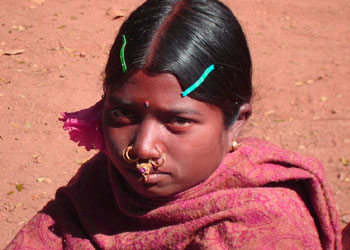
CLOTHINGS The men normally wear loin cloths and napkins. On the other hand the women wears coarse and cheap sarees. But with the modern contacts they are now wearing shirts, banyans, blouses and colorful sarees, ribbons etc. Common ornaments worn by Paraja Lady are hair pins, necklaces, rings, bracelets, bangles and armlets. These ornaments are made of silver, aluminium, brass and sometimes gold. |
SAORA TRIBE ODISHAThe Saoras are one of the oldest tribes of India. Frequent references were found in Hindu Mythology and classics on this tribe. More often they found in the Sanskrit Literature, The Epics, Puranas and other religious books/texts. They are known in various names such as Savara / Sabara / Saur / Sora etc. They have a racial affinity with the proto-Australoid physical features which is dominant among the aborigines of Central India. These tribes found in Gunupur sub-division of Rayagada District. The Saoras are the best terrace cultivators. In the terraced fields water flows throughout the year. The terraces are built right up the beds of the hill slopes, in some places rising up to the hill tops. They grow two varieties of paddy in the fields. The early variety is called Ambadhan and the late variety is called as Badadhan. They cultivate ragi in the dry fields. CLOTHINGS MEN SAORA The Saora man wears a loin cloth which is six feet long and ten inches in breadth. This is decorated with red tassels at the ends. This cloth is tied around the hips and hang down in two strips, one in the front and the other at the back. Because of the dress design they are known as Lanjia Saora. The man also wears a necklace made of beads occasionally. |
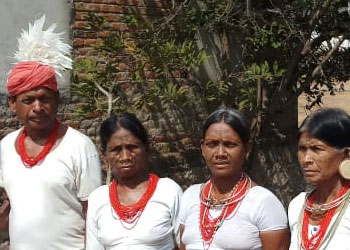
WOMEN DRESS CODE Whereas the Saora woman dresses herself with a waist cloth with gray/red borders which hardly reaches knee. The dress/cloth is about three feet in length and two feet in breadth. During chilly winter the woman cover the upper part of the body with another piece of cloth. These cloths are woven by the Doms from yarn, hand spun by themselves. The woman cover the upper part of the body with blouse. Saora women does not use huge bundles of necklaces of beads. They wear a few necklaces of beads, round wooden in the earlobes with nose rings. |
TRIBAL ATTRACTION

What we offer for odisha tribal packages
Our Compnay
Our Packages
Travel Informations
Contact Info
Flat No. 301, Kamala Villa,
Kalinga Vihar,
Bhubaneswar-751019
Odisha, India
Mob: 0091-9937187790
Email: tours@indedvoyage.com
Copyright 2018 © All Rights Reserved

